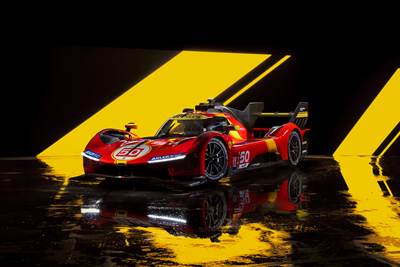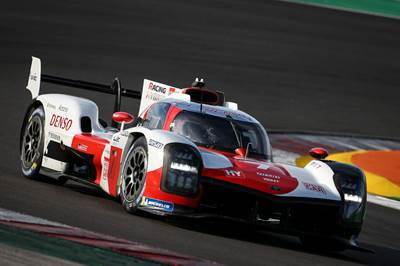McLaren celebrates 10 years of the McLaren P1 hybrid hypercar
Lightweight carbon fiber construction, Formula 1-inspired aerodynamics and high-performance hybrid powertrain technologies hallmark this hybrid vehicle, serve as a springboard for new race cars.
​â¶Ä‹â¶Ä‹â¶Ä‹â¶Ä‹â¶Ä‹
The McLaren P1. Photo Credit, all images: McLaren
(Woking, U.K.) celebrates the 10-year anniversary of the reveal of the production version of the McLaren P1. Unveiled at the 2013 Geneva Motor Show, this hypercar is recognized as a landmark for McLaren and the development of high-performance hybrid vehicles — showcased most recently by the all-new McLaren Artura (read, “Newly debuted Artura GT4 features McLaren Carbon Lightweight Architecture”).
Created with the intention of being “the best driver’s car in the world on both road and track,” the design and technical specifications of the McLaren P1 provided the ideal foundation to deliver on this ambition. A series of testing and development achievements during 2013 — including lapping the famous Nürburgring Nordschleife — cemented the car’s credentials, according to the company. Alongside a benchmark hybridized, petrol-electric powertrain, the hypercar has been underpinned by two of McLaren’s trademark strengths: low vehicle weight and aerodynamic excellence.
Light weight remains a priority for McLaren’s vehicles. The MonoCage carbon fiber monocoque with roof at the core of the McLaren P1 was a development of the MonoCell structure used in McLaren’s 12C supercar and key to optimizing mass in a vehicle with a dry weight of just 1,395 kilograms (3,075 pounds). The McLaren P1’s body panels are also carbon fiber and comprise a large clamshell; single-molded front and rear panels attached to the central MonoCage; two small access flaps in the rear; a front bonnet and the two doors. Weighing a total of only 90 kilograms, the panels are thin but also strong. A hybrid battery, which is mounted low inside the carbon fiber MonoCage, weighs 96 kilograms.
A 3.8-liter, twin-turbocharged M838TQ V8 engine developing 737PS (727 bhp) is combined with a lightweight electric motor producing 179PS (176 bhp) to give a total of 916PS (903 bhp). According to McLaren, this delivers a high level of performance. For example, the hypercar is capable of acceleration from zero to 100 kilometers/hour (62 miles/hour) in 2.8 seconds; zero to 200 kilometers/hour (124 miles/hour) in 6.8 seconds and zero to 300 kilometers/hour (186 miles/hour) in 16.5 seconds — a full five seconds quicker than the McLaren F1. A maximum speed of 350 kilometers/hour (217 miles/hour) is possible.
McLaren P1 and Artura.
The large rear wing of the McLaren P1 optimizes aerodynamics by adjusting automatically. It can extend rearwards by up to 300 millimeters on track and 120 millimeters on road. This was developed using the same software and methodology as the McLaren Formula 1 team. A drag reduction system (DRS) was integrated into its design to reduce downforce and increase straight-line speed, achieved through the pitch of the rear wing, rather than by using a removable flap. A combination of computational fluid dynamics (CFD) aerodynamic modeling and many hours spent in a wind tunnel focusing on aerodynamic performance, resulted in downforce of 600 kilograms at well below maximum speed.
When developed, no floor carpet was installed (it was deemed unnecessarily heavy) and no sound deadening. The glass was re-engineered to reduce weight, chemically toughened, and only 2.4 millimeters thick. The windscreen is just 3.2 millimeters thick, including a plastic interlayer, saving (at the time) 3.5 kilograms over the 4.2-millimeter-thick screen of the 12C.
Exclusive and highly desirable, the McLaren P1 sold out within months of reveal and by November all 375 cars were allocated. Build of the first of the 375 McLaren P1 production models were completed in September 2013. The final customer-ordered car was completed in December 2015.
Ten years after its Geneva Motor Show appearance — and the same year McLaren is celebrating the 60-year anniversary of Bruce McLaren founding the company — the McLaren P1 is said to remain an exciting and dynamically accomplished performer on both road and track. In addition to maintaining an enduring legacy in McLaren’s lineage of technologically advanced, driver-focused cars, as a precursor of electrification as an enhancement to driving engagement, the vehicle has changed perceptions of the technology, inspiring the Artura’s performance and driving dynamics with electric vehicle (EV) driving capability.
For additional facts about the McLaren P1, .
Related Content
ASCEND program completion: Transforming the U.K.'s high-rate composites manufacturing capability
GKN Aerospace, McLaren Automotive and U.K. partners chart the final chapter of the 4-year, £39.6 million ASCEND program, which accomplished significant progress in high-rate production, Industry 4.0 and sustainable composites manufacturing.
Read MoreHonda begins production of 2025 CR-V e:FCEV with Type 4 hydrogen tanks in U.S.
Model includes new technologies produced at Performance Manufacturing Center (PMC) in Marysville, Ohio, which is part of Honda hydrogen business strategy that includes Class 8 trucks.
Read More“Structured air” TPS safeguards composite structures
Powered by an 85% air/15% pure polyimide aerogel, Blueshift’s novel material system protects structures during transient thermal events from -200°C to beyond 2400°C for rockets, battery boxes and more.
Read MoreTPI manufactures all-composite Kenworth SuperTruck 2 cab
Class 8 diesel truck, now with a 20% lighter cab, achieves 136% freight efficiency improvement.
Read MoreRead Next
Ferrari unveils 2023 Le Mans 499P Hypercar
The car manufacturer’s first World Endurance Championship in 50 years, the four-wheel drive prototype combines innovation with tradition, featuring composites, a hybrid engine and an aerodynamic design.
Read MorePermali develops tougher, more eco-friendly composite parts for motorsport
Formula 1 and Hypercar manufacturer in Gloucester, U.K., develops “greener composites” that meet increasing technical demands while still conforming to safety, performance and quality.
Read MoreUltrasonic welding for in-space manufacturing of CFRTP
Agile Ultrasonics and NASA trial robotic-compatible carbon fiber-reinforced thermoplastic ultrasonic welding technology for space structures.
Read More












